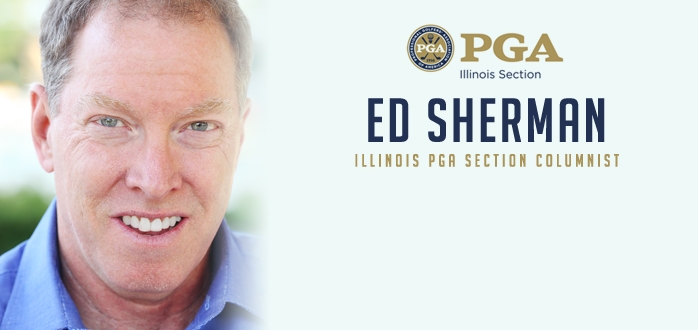Agreed, getting players to play from the correct tee boxes is a win-win for everyone. The player is far more likely to have fun playing from more manageable yardages. Pace of play also is substantially improved, much to the delight of golf course operators.
Bottom line: Everyone benefits.
Ah, but there is one big problem. How do you get players to play from the proper tees?
“All it takes is for one guy from the group to say, ‘Let’s play from the tips,’ and they all go back there,” said Ethan Roush, the Head PGA Professional at the Glen Club. “It seems nobody wants to be the guy who says, ‘Let’s play from the tees that are suited for our skill level.’”
This isn’t to say that the issue hasn’t been addressed. In 2011, the PGA of America and the USGA launched the “Tee It Forward” initiative. It was a progressive idea to get players to play a tee forward from where they usually play. In most cases, they would hit from tees that are a better fit for their games. Jack Nicklaus was among the big names who were prominent in the ad campaign.
“All of us deeply involved in the game constantly encourage golfers of all skill levels to play the proper tees, but too often golfers want to bite off as much of the golf course as they can,” Nicklaus said. “What ends up suffering is their scorecard and their overall enjoyment. This program should help stimulate people to play the proper tees and maximize the golf experience."
Of course, Nicklaus is correct. However, as someone who plays a myriad of courses, mostly public but also several private, I am here to say that more still could be done to make sure players are playing from the proper tees.
I rarely encounter a starter who gives advice on what tees our group should play based on our handicaps. Most scorecards also don’t have suggestions on what tee box would be best for our games. And very few scorecards offer the option of allowing players to play combination tees, allowing them to encounter a nice mix of long and shorter holes.
For all the talk about far the ball is going these days, the gains usually are seen by only the best players of the world. A 2017 distance report commissioned by the USGA and R&A showed driving distance across all age groups and all handicaps is at best flat and in many cases declining. According to the study, the average change across all age groups (20s to 70s) in driving distance was a loss of 4.1 yards from 2015-'18.
Yet recreational players with unchecked egos continue to trek to the back tees, yours truly included. As a 58-year old who plays to a 13 handicap, I often find tees beyond 6,500-6,600 yards are a challenge. When I play that distance with par 4s averaging 380-400 yards, requiring long second shots for me, I joke that I only need to carry four clubs on most holes: A driver, hybrid, wedge and putter.
The Glen Club is a facility that attempts to be proactive in regards to tee boxes. During a recent round we had out there, the starter, Joe, made suggestions on what tees we should play based on our handicaps. The Glen Club also places signage by the first tee with recommendations for appropriate tee boxes
“From a course operations perspective, it always is in our best interests to get players to play from the right tee, and when appropriate, to move up a tee,” Roush said.
Do players heed the advice? Hardly. As Roush said, usually all it takes is for the one guy in the group who wants to play back.
However, Jeff Pajula, the Head PGA Professional at Stonewall Orchard, has noticed some players are getting the message at his course. It just takes some persistence.
“We have some older gentlemen who finally moved up a tee,” Pajula said. “They had been stubborn about it. But once they did it, they came back saying how much they enjoyed their games. The key is getting people to do it for the first time.”
If players won’t move up a full tee, how about a half tee? Combination tees are a terrific alternative, allowing players to split the difference between tee boxes. For instance, at the Glen Club, the blue tees are 6,620 yard with a 135 slope. The silver tees are 6,062 yards with a 128 slope. That’s a big gap, and frankly, 6,062 yards still is too short for me.
However, the Glen Club gives players the option of playing a combination of the blue and silver tees with a yardage of 6,316 yards, which has a 131 slope. It plays back on 8 holes, including two of the four par 5s. But more importantly, it plays up on the long par 3s and 4s. For instance, on No. 3, the silver tee is 386 yards compared to 426 yards from the blue.
Stonewall Orchard has a similar situation. The gold tees, one up from the tips, are 6,506 yards while the white tees are 6,032. Its gold-white combination tees are 6,202 yards.
Pajula points to the par 3 fifth, where it plays to 187 yards from the gold. However, if golfers are using the combination tees, it plays to 170 yards from the white.
“At almost 190 yards, most (recreational) players are using a long hybrid,” Pajula said. “They have a much better chance of hitting the green from the closer tee.”
It all makes perfect sense. We played from the combination tees during our round at the Glen Club. While it still was plenty challenging, it was nice to pull shorter clubs on many holes.
Pajula says Stonewall starters inform players of the combination tee option prior to beginning their rounds. Stonewall’s scorecard also lists recommendations for tee boxes based on handicap.
“We’ve got to sell (the combination tee) on the first tee,” Pajula said. “It’s been successful once the players know about it.”
Pace of play is the biggest benefit to players playing from appropriate tees. For instance, the difference in moving up 20 yards could be a player carrying a creek in front of the green with a shorter club. That quickens the round as opposed to the player hitting it in the water, looking for his ball, and then setting up for another crack at the green.
“If you can shave 10-15 minutes off a round because someone clears water hazard or clears a bunker, that helps a lot,” Roush said. “You’re going to enjoy the round more.”
Isn’t enjoying golf what it is all about? Tell your members and regulars to move up. They’ll have more fun.

